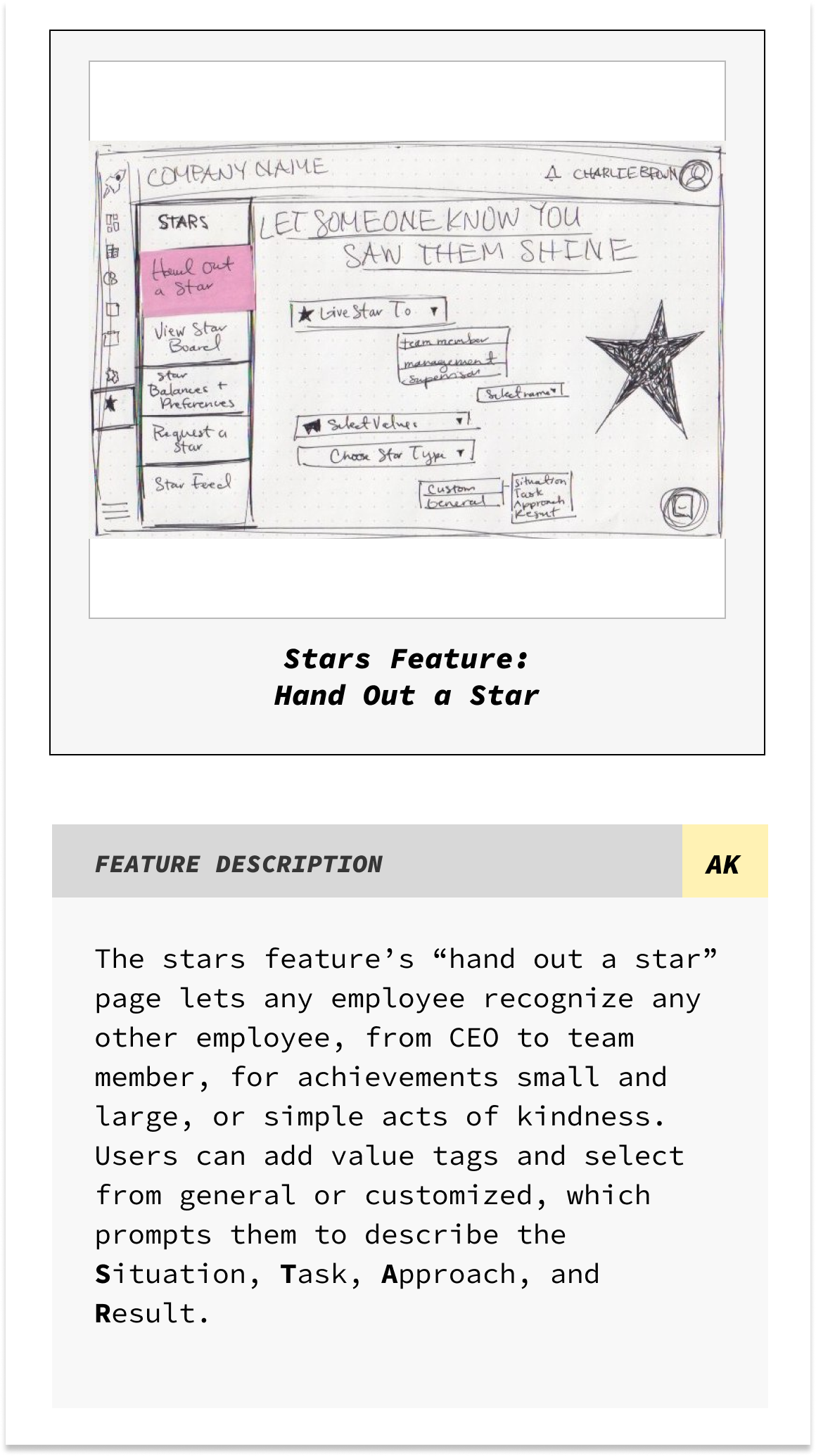Culture Booster
Extending an existing design for a SaaS platform
Project Overview
Culture Booster is a successful startup that is on a mission to improve people’s work lives through their employee engagement software. They reached out to my team for help with designing and prioritizing new features.
Planning Phase
Competitive Analysis
After looking at different platforms that offer similar services, I made the decision to design a feature that lets employees receive recognition for their work. Culture Booster wanted this feature, and the competitive analysis revealed that every product we reviewed already had some version of it.
Other opportunity areas uncovered:
Employee incentives
Social platform
Integration with other work platforms, such as Slack
Goal setting
Analytics
Stakeholder Interview
A meeting with the CEO of Culture Booster gave me insight into the company’s culture; ways to integrate that into my feature; and specific requirements for the employee recognition feature. They envisioned it as being called STARs. Included among their wishlist for STARs:
Two options for sending stars: general (a simple recognition) and anecdotal (a prompt to explain the Situation, Task, Action, and Result)
A repository of stars received for employees to look at when they need encouragement
Customized value tags to indicate the particular value(s) an employee displays
Customized rewards (e.g. desired gift cards)
User Journey Map
With Culture Booster’s goals in mind, I created a user journey map that follows the journey of an employee who feels burnt out and disconnected at work. By mapping out the steps she would take in this situation using Culture Booster, I was able to pinpoint specific places in the user journey that might be improved upon with the new employee recognition feature. One concept identified was giving employees the opportunity to request recognition or feedback when they needed it most.
Design Phase
Feature Concept Cards
My feature concept cards for the recognition feature are shown below. I used the simple pen-and-paper method with a pink post-it note to indicate the screen being displayed.
Kano Analysis
After presenting the entire team’s feature concept cards to both Stephan and a Culture Booster developer to learn more about the engineering timelines associated with each idea, my team voted on ten designs to move forward with. From there, a Kano analysis was done to prioritize between those ten features. Kano Analysis is a user and data driven method for determining what features to prioritize when developing a product. Features get categorized into one of five categories:
Required: Must-have features
Desired: Features that should be included when possible because users’ perception of the product’s value will increase with their inclusion
Exciter: Features that may delight users but will not cause frustration or disappointment if they are not included
Neutral: Features that will not impact users either way
Anti-Feature: Features that should be removed or left off a product because they can negatively impact the user experience.
Annotated Wireframes
I moved forward with designing a recognition feature because the Kano analysis revealed that this was a feature to be prioritized. I did not design each feature that I originally conceptualized but narrowed it down to the features that the Kano analysis, stakeholder meetings, and secondary research revealed to be the most important to users. Additionally, I tied my design choices back to the values of empathy and gratitude that are at the core of Culture Booster’s foundation by adding in a feature that is not required for this software but that would delight the users. I intentionally proposed my designs with room left in the budget for the developers to expand on features.
Conclusion
Next Steps
With this sprint, I was unable to add the level of detail necessary to create an interactive prototype and test it with users. This step would elicit more human insights on how to best proceed with developing these important features. It would be at the top of the to-do list for a continuation of this project. Additional features should also be made priorities, as the research in this project made clear. The top features to focus on next would be employee suggestions and a dashboard.
Reflection
The lessons taken away from this project will serve me well as I continue to practice human-centered design as part of the holistic process of creating products and services for people. I look forward to utilizing Kano analysis to help narrow my scope for ambitious work; working more with developers to continue learning that side of things; and honing my UI design skills to build simple, convenient, and functional processes for people.











